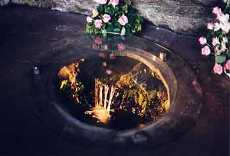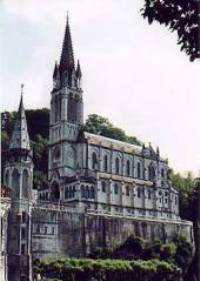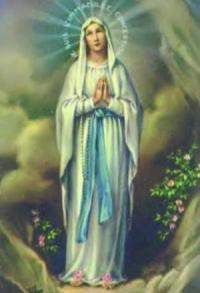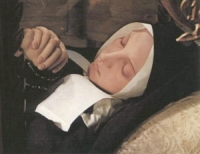Our Lady of Lourdes
The Story of "Our Lady of Lourdes"
The village of Lourdes, France receives a staggering 6 million pilgrim visitors each year. In 2008, it will observe the 150th anniversary of Mary's apparitions to Bernadette: you can visit the Lourdes Jubilee site here. You may visit the portal of official Lourdes websites here.
Bernadette's Youth

Saint Bernadette was born in 1844, the eldest of Francois and Louise Soubirous’ nine children, five of whom died in infancy. The family ran a flour mill in Lourdes France, population about 4,000, located just north of France's border with Spain. The family lived in dire poverty, in cramped quarters (they called their home “the dungeon”), but were obliging, generous Christians of irreproachable integrity. At the age of 5, Bernadette began to suffer from asthma, which would stunt her growth, and plague her health for the rest of her life. Due to her family’s poverty, and her position as first-born, much of Bernadette’s young life was taken up in helping her mother with household chores, errands and minding her younger siblings. Therefore, she seldom attended school, was unable to read, and spoke the local dialect rather than French. Despite the fact that she had not been educated in the Catechism, Bernadette was a loving, obedient, modest and prayerful child with a deep love for God and for Mary. She prayed the Rosary frequently, always carrying a plain set of beads in her pocket, and longed to make her First Communion, which she did later than other children.
The First Apparition of Mary to Bernadette
The story of 14-year old Bernadette’s encounters with Our Lady began on Thursday February 11, 1858. That morning, Bernadette received her mother’s permission to go for a walk to gather some wood, having been volunteered by her 12-year old sister Toinette and Toinette’s adventurous classmate Jeanne. The three girls made their way along the Gave River to a meadow, an area Bernadette had never been before, called Massabielle. In order to reach this meadow, the girls had to cross an approximately 15-foot wide canal. Toinette and Jeanne hiked up their skirts and waded through the knee-deep, icy water, but Bernadette stayed put due to her more delicate health, and the fact that she had a mild cold. Once her two companions were warming up their feet on the other side, Bernadette called to Toinette to toss some large rocks into the water by which to step across, then asked Jeanne to carry her across. But the girls continued on their way and out of sight, leaving her behind for a good 15 minutes.
Across the water from Bernadette was a large cave, or grotto. A little to the upper right of its opening, was an oval recess in the rock. Out of this cavity grew the branches of some shrubs and a wild eglantine rose bush which trailed down the rock wall. Bernadette did not want her sister off alone with Jeanne, so she decided to cross the icy stretch of water anyway, and in her own words…
Our Lady and Bernadette Pray the Rosary Together
“I had hardly begun to take off my stocking when I heard the sound of wind, as in a storm. I turned towards the meadow, and I saw that the trees were not moving at all. I had half-noticed, but without paying any particular heed, that the branches and brambles were waving beside the grotto.
I went on taking my stockings off, and was putting one foot into the water, when I heard the same sound in front of me. I looked up and saw a cluster of branches and brambles underneath the topmost opening in the grotto tossing and swaying to and fro, though nothing else stirred all around.
Behind these branches and within the opening, I saw immediately afterwards a girl in white, no bigger than myself, who greeted me with a slight bow of the head; at the same time, she stretched out her arms slightly away from her body, opening her hands, as in pictures of Our Lady; over her right arm hung a rosary.
I was afraid. I stepped back. I wanted to call the two little girls; I hadn’t the courage to do so. I rubbed my eyes again and again: I thought I must be mistaken.
Raising my eyes again, I saw the girl smiling at me most graciously and seeming to invite me to come nearer. But I was still afraid. It was not however a fear such as I have had at other times, for I would have stayed there for ever looking at her: whereas, when you are afraid, you run away quickly.
Then I thought of saying my prayers. I put my hand in my pocket. I took out the rosary I usually carry on me. I knelt down and I tried to make the sign of the Cross, but I could not lift my hand to my forehead: it fell back.
The girl meanwhile stepped to one side and turned towards me. This time, she was holding the large beads in her hand. She crossed herself as though to pray. My hand was trembling. I tried again to make the sign of the Cross, and this time I could. After that I was not afraid.

I said my Rosary. The young girl slipped the
beads of hers through her fingers, but she
was not moving her lips.
While I was saying my Rosary, I was
watching as hard as I could. She was
wearing a white dress reaching down to
her feet, of which only the toes appeared.
The dress was gathered very high at the
neck by a hem from which hung a white
cord. A white veil covered her head and
came down over her shoulders and arms
almost to the bottom of her dress. On
each foot I saw a yellow rose. The sash of
the dress was blue, and hung down below
her knees. The chain of the rosary was yellow; the beads white, big and widely spaced. The girl was alive, very young and surrounded with light. When I had finished my Rosary, she bowed to me smilingly. She retired within the niche and disappeared all of a sudden.”
Afterwards, when Bernadette was questioned, she added that the Lady was momentarily preceded by a “golden cloud”, and a “halo” which also lingered for a moment after she left. She seemed to be penetrated with a “soft light”, which neither hurt nor dazzled the eyes. Her face was oval and “of an incomparable grace”, her eyes were blue, her voice “oh, so sweet!”. A little of her hair could be seen at her temples and through the veil on her forehead, yet Bernadette never noticed its exact colour. At times, the Lady pressed the palms of her hands together as one does in prayer, though her rosary had only five decades as Bernadette’s did.
Of particular interest, the Lady and Bernadette kept time with each other as they slipped the rosary beads through their fingers. Bernadette explained that, during the recitation of the Lord’s Prayer (“Our Father…”) and the Hail Mary, the Lady did not move her lips, except to smile; but when they came to the Glory Be, the Lady bowed her head and visibly recited this prayer. As Abbe Francois Trochu states in his book Saint Bernadette Soubirous,
“This last detail, which the little one in her ignorance could not have invented, reveals an accurate and deep theological truth. The Gloria (Glory Be), which is a hymn of praise to the Adorable Trinity, and is Heaven’s Canticle, is indeed the only part of the Rosary suitable for Her" (Mary) … "The Pater" (Our Father) "is the prayer of needy mortals, tempted and sinful, on their journey to the Fatherland; as for the Ave," (Hail Mary) "the Angels greeting, this could be used only by the visionary," (Bernadette) "as the Apparition had no need to greet her own self."
Subsequent Apparitions
When Bernadette's parents learned of her experience, they forbade her to return to the grotto, but her mother soon relented and allowed another visit on February 14. This time, Bernadette took some holy water, which she sprinkled toward the apparition in an effort to find out if it was from God. Again, her parents were unwilling for her to return, but allowed a third visit on February 18, in order to settle the rumour circulating that the apparition was the soul of a saintly dead parishioner. During this apparition, the Lady spoke for the first time, telling Bernadette, "I do not promise to make you happy in this world but in the other", after which the Lady asked, "Would you be kind enough to come here for a fortnight?" (A fortnight equals 14 days.) Before each encounter with the Lady, Bernadette would be irresistably drawn to the grotto, as if by supernatural invitation. The fortnight's remaining apparitions occurred during the rest of February and first part of March, ending March 4.
Bernadette’s story met with scepticism from the Church and intimidating interviews from the civil authorities, including a judge who threatened her with prison. Those who accompanied Bernadette to the grotto grew from a handful to thousands from around the region. At the moment each apparition began, Bernadette would go into an ecstasy and was oblivious to any physical interventions - including a candle's flame touched along her hand, which a medical doctor named Douzous witnessed on April 7, during one of two subsequent apparitions.
The Message of Lourdes and the Miraculous Spring
During the February 24 apparition, the Lady spoke again: ‘Penance! Penance! Penance! Pray to God for sinners.’ She asked Bernadette to kiss the ground for the conversion of sinners. The following day, the crowd saw Bernadette back at the grotto, scraping in the mud then attempting to drink and wash her face with it, as if with water. She did this in response to the Lady's instruction to 'Go and drink at the spring and wash yourself in it'. Again in response to the Lady's direction, Bernadette then ate the bitter leaves of a herb that was growing nearby. At this, many people dismissed Bernadette, believing her to be mad, but she explained herself with the words "It is for sinners". However, where there had previously been no water, a spring appeared and flows to this day. In fact, dozens of documented physical healings and countless spiritual healings have taken place at this spring

ever since. The first physical miracle occurred hours before the March 1 apparition: after a friend of the Soubirous family, Catherine Latapie, plunged her dislocated arm into the spring water it regained normal movement. For many decades now, this miraculous spring water has been bottled and distributed to people worldwide, while much of it is diverted for bathing purposes. Although Lourdes' present-day population is only 17,000, it receives a staggering 6 million pilgrim visitors every year. In 2008, Lourdes will observe the 150th anniversary of Mary's apparitions there: you can visit their Jubilee site here, or visit the portal of official Lourdes websites here.
Pictured right: the Lourdes spring
The Lourdes Basilica

As the fortnight of meetings continued,
the Lady renewed her requests for
prayer and penance.
On March 2 and 3, the Lady said, "Go and
tell the priests that people are to
come here in procession and to build
a chapel here." Since then, and every
evening since 1872, thousands
partake in a 1 1/2-hour candlelit
procession at 9PM.
Pictured left: the Lourdes Basilica
The following day, the last of the
requested fortnight, a huge crowd
gathered and after Bernadette
finished the Rosary the people questioned her, but there had been no further message or revelation.
'The Lady' Identifies Herself to Bernadette
The Blessed Virgin Mary would appear to Bernadette a total of 18 times from February to July that year, 1858. In the words of Bernadette, during one of the final apparitions, which took place on March 25,

”I begged her once more to do me the favour of telling me her name.”
Again, from Abbe Trochu’s book, “…the Apparition, who, until then, had kept her hands joined, opened her arms and lowered them as on the Miraculous Medal, thus causing her rosary of alabaster and gold to slip down towards her wrist: it was her blessing on the redeemed earth. Then she joined her hands again and brought them close to her breast, as if to restrain the throbbing of her heart. Finally, raising her eyes to Heaven, in the attitude of the ancient Magnificat, she delivered her secret:
”I AM THE IMMACULATE CONCEPTION.”
Then the Apparition “smiled again, spoke no more, and disappeared smiling”. Bernadette kept repeating these words, "immaculate conception", on her way to tell the parish priest. She did not understand what they meant, but the parish priest did.
What is stunning about this revelation of the apparition's identity, of which Bernadette was ignorant, is that just over three years earlier, on December 8, 1854, Pope Blessed Pius IX had proclaimed for the first time the Church’s doctrine, that the Blessed Virgin Mary was preserved from all stain of original sin from the first moment of her conception. And of course the Church has long celebrated the Feast of the IMMACULATE CONCEPTION every December 8.
Our Lady appeared to Bernadette for the last time, on July 16 of the same year, 1858. By then the authorities had put barricades around the grotto to prevent anyone from entering, so she saw Our Lady from the opposite bank of the River Gave and described her as "more beautiful than ever". The barricades were then taken down on the order of Napoleon III. And Bernadette had, at last, received her First Communion on June 3, the Feast of Corpus Christi.
Bernadette's Remaining Years
Life was not easy for Bernadette following the eighteen apparitions, as she disliked the publicity that surrounded her. She answered briefly the questions of the curious, but would be irritated by offers of gifts or money. In July 1860 she moved to the hospice at Lourdes to complete her neglected education and stayed there for six years.
As early as July 1858, the local bishop had set up a commission to study the apparitions and some reported cures. In January 1862, the commission's findings prompted the bishop to declare: "We judge that Mary Immaculate, Mother of God, really did appear to Bernadette Soubirous ...".
While at the hospice Bernadette decided to join the Sisters of Charity and Christian Instruction of Nevers. She was accepted in November 1864, but her entry was delayed because of her poor health, the death of her brother Justin (aged ten) and the bishop’s wish that she attend the inauguration of the building of the crypt above the grotto in May 1866.
Bernadette arrived at the convent of Nevers in July 1866, where she professed as Sister Marie-Bernard and, in spite of frequent bouts of

ill-health, worked in the sacristy and
infirmary. During her last few years,
Sr. Marie-Bernarde suffered terribly, yet
with exceeding humility, from tuberculosis
of the bone, and died at the age of 35.
The Church celebrates her feast day on
April 16, the anniversary of her death in
1879. To this day, the saint's incorrupt
body lies in a glass casket (for public
viewing) in the Convent of the Sisters at Nevers, France.


